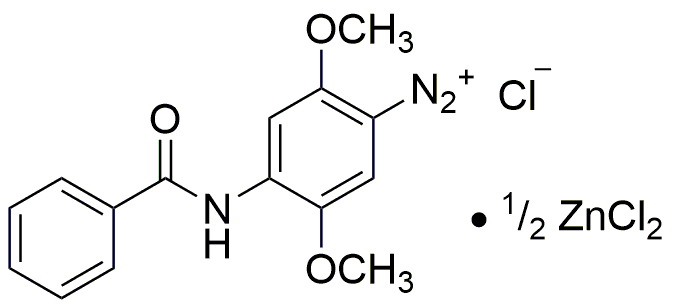Fast Blue RR Salt is widely utilized in research focused on:
- Histology and Pathology: This compound is commonly used as a dye in histological staining techniques, allowing researchers to visualize cellular structures and identify specific tissue types in biological samples.
- Neuroscience: It serves as a tracer for neuronal pathways, helping scientists map the connections between different brain regions, which is crucial for understanding brain function and disorders.
- Environmental Monitoring: Fast Blue RR Salt is employed in assessing the presence of specific pollutants in water samples, providing a reliable method for environmental scientists to monitor water quality.
- Food Industry: The compound is used as a colorant in food products, offering a vibrant hue while meeting regulatory standards for safety and consumption.
- Textile Industry: It is also applied in dyeing processes, providing bright and stable colors to fabrics, which enhances the aesthetic appeal of textile products.
General Information
Properties
Safety and Regulations
Applications
Fast Blue RR Salt is widely utilized in research focused on:
- Histology and Pathology: This compound is commonly used as a dye in histological staining techniques, allowing researchers to visualize cellular structures and identify specific tissue types in biological samples.
- Neuroscience: It serves as a tracer for neuronal pathways, helping scientists map the connections between different brain regions, which is crucial for understanding brain function and disorders.
- Environmental Monitoring: Fast Blue RR Salt is employed in assessing the presence of specific pollutants in water samples, providing a reliable method for environmental scientists to monitor water quality.
- Food Industry: The compound is used as a colorant in food products, offering a vibrant hue while meeting regulatory standards for safety and consumption.
- Textile Industry: It is also applied in dyeing processes, providing bright and stable colors to fabrics, which enhances the aesthetic appeal of textile products.
Documents
Safety Data Sheets (SDS)
The SDS provides comprehensive safety information on handling, storage, and disposal of the product.
Product Specification (PS)
The PS provides a comprehensive breakdown of the product’s properties, including chemical composition, physical state, purity, and storage requirements. It also details acceptable quality ranges and the product's intended applications.
Certificates of Analysis (COA)
Search for Certificates of Analysis (COA) by entering the products Lot Number. Lot and Batch Numbers can be found on a product’s label following the words ‘Lot’ or ‘Batch’.
*Catalog Number
*Lot Number
Certificates Of Origin (COO)
This COO confirms the country where the product was manufactured, and also details the materials and components used in it and whether it is derived from natural, synthetic, or other specific sources. This certificate may be required for customs, trade, and regulatory compliance.
*Catalog Number
*Lot Number
Safety Data Sheets (SDS)
The SDS provides comprehensive safety information on handling, storage, and disposal of the product.
DownloadProduct Specification (PS)
The PS provides a comprehensive breakdown of the product’s properties, including chemical composition, physical state, purity, and storage requirements. It also details acceptable quality ranges and the product's intended applications.
DownloadCertificates of Analysis (COA)
Search for Certificates of Analysis (COA) by entering the products Lot Number. Lot and Batch Numbers can be found on a product’s label following the words ‘Lot’ or ‘Batch’.
*Catalog Number
*Lot Number
Certificates Of Origin (COO)
This COO confirms the country where the product was manufactured, and also details the materials and components used in it and whether it is derived from natural, synthetic, or other specific sources. This certificate may be required for customs, trade, and regulatory compliance.


